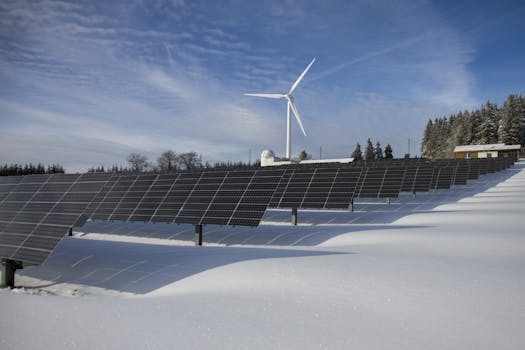“Power Your Future: Seamlessly Integrate Solar Panels with Wind Turbines for Ultimate Energy Independence!”
Integrating solar panels with a wind turbine system can create a hybrid renewable energy setup that maximizes energy production and enhances reliability. This combination allows for the harnessing of solar energy during sunny days and wind energy during breezy conditions, providing a more consistent power supply. Wiring solar panels to a wind turbine system involves understanding the electrical components, including charge controllers, inverters, and batteries, to ensure efficient energy management. Proper installation and configuration are essential for optimizing performance and ensuring safety. This guide will outline the steps and considerations necessary for successfully wiring solar panels to a wind turbine system.
Understanding Solar Panel and Wind Turbine Compatibility
When considering the integration of solar panels with a wind turbine system, it is essential to understand the compatibility of these two renewable energy sources. Both technologies harness natural resources to generate electricity, yet they operate under different principles and conditions. Solar panels convert sunlight into electricity through photovoltaic cells, while wind turbines utilize the kinetic energy of wind to turn blades connected to a generator. This fundamental difference in operation means that careful planning is required to ensure that both systems can work harmoniously together.
To begin with, it is crucial to assess the energy needs of your household or facility. By calculating your average energy consumption, you can determine the appropriate size and number of solar panels and wind turbines required for your system. This assessment will also help you understand how much energy each source can contribute, allowing for a more efficient design. For instance, solar panels are most effective during sunny days, while wind turbines can generate power even during cloudy or stormy weather. This complementary nature of the two systems can lead to a more stable and reliable energy supply.
Next, consider the location of your solar panels and wind turbine. The efficiency of both systems can be significantly affected by their placement. Solar panels should be installed in an area that receives maximum sunlight exposure throughout the day, ideally facing south in the northern hemisphere. On the other hand, wind turbines require an open space with minimal obstructions to capture wind effectively. It is important to conduct a site assessment to identify the best locations for both systems, ensuring that they do not interfere with each other’s performance.
Once you have established the energy needs and optimal locations, the next step is to select the appropriate components for your hybrid system. This includes choosing the right inverter, which is crucial for converting the direct current (DC) generated by solar panels into alternating current (AC) used by most household appliances. Additionally, a charge controller is necessary to manage the energy flow from both sources, preventing overcharging of batteries if you choose to incorporate energy storage. It is also advisable to invest in a battery bank to store excess energy generated during peak production times, ensuring that you have a reliable power supply during periods of low generation.
Moreover, understanding the electrical compatibility between solar panels and wind turbines is vital. Both systems should ideally operate on the same voltage to ensure seamless integration. If the voltage levels differ, a step-up or step-down transformer may be required. Furthermore, it is essential to use appropriate wiring and connectors to handle the combined output of both systems safely. This not only enhances efficiency but also minimizes the risk of electrical hazards.
In conclusion, wiring solar panels to a wind turbine system requires a comprehensive understanding of their compatibility and operational dynamics. By assessing energy needs, optimizing placement, selecting suitable components, and ensuring electrical compatibility, you can create a robust hybrid energy system. This integration not only maximizes the use of renewable resources but also contributes to a more sustainable and resilient energy future. As the world increasingly turns towards renewable energy solutions, understanding how to effectively combine these technologies will play a crucial role in achieving energy independence and reducing carbon footprints.
Essential Components for Wiring Solar Panels to Wind Turbines

When considering the integration of solar panels with a wind turbine system, understanding the essential components required for effective wiring is crucial. This combination not only enhances energy production but also ensures a more reliable and sustainable power supply. To begin with, the primary components include the solar panels themselves, the wind turbine, a charge controller, batteries for energy storage, an inverter, and the necessary wiring and connectors. Each of these elements plays a vital role in the overall functionality of the system.
Solar panels convert sunlight into electricity through photovoltaic cells, making them a fundamental part of any solar energy system. When selecting solar panels, it is important to consider their wattage and efficiency ratings, as these factors will influence the overall energy output. Similarly, the wind turbine harnesses wind energy, converting it into electrical power. The choice of wind turbine should be based on the average wind speed in your area, as well as the turbine’s rated capacity, which determines how much energy it can produce under optimal conditions.
Once the solar panels and wind turbine are in place, the next essential component is the charge controller. This device regulates the voltage and current coming from the solar panels and wind turbine, ensuring that the batteries are charged efficiently without being overcharged. A good charge controller will also prevent the batteries from discharging back into the solar panels or wind turbine during periods of low energy production. This is particularly important in hybrid systems, where energy generation can fluctuate significantly based on weather conditions.
Batteries are another critical component, as they store the energy generated by both the solar panels and the wind turbine. When selecting batteries, it is essential to consider their capacity, which is typically measured in amp-hours (Ah). The capacity should be sufficient to meet your energy needs during periods when both solar and wind energy production is low. Additionally, deep-cycle batteries are often recommended for renewable energy systems, as they are designed to be discharged and recharged repeatedly without significant degradation.
The inverter is another key component in this setup, as it converts the direct current (DC) produced by the solar panels and wind turbine into alternating current (AC), which is the standard form of electricity used in most homes. When choosing an inverter, it is important to ensure that it can handle the combined output of both the solar panels and the wind turbine. Some inverters are specifically designed for hybrid systems, allowing for seamless integration of multiple energy sources.
Finally, the wiring and connectors used in the system must be of high quality to ensure safety and efficiency. Proper gauge wiring is essential to minimize energy loss and prevent overheating. Additionally, using weather-resistant connectors will help protect the system from the elements, ensuring longevity and reliability.
In conclusion, wiring solar panels to a wind turbine system requires careful consideration of several essential components. By selecting the right solar panels, wind turbine, charge controller, batteries, inverter, and wiring, you can create a robust hybrid energy system that maximizes energy production and enhances sustainability. This integration not only provides a reliable power source but also contributes to a greener future, making it a worthwhile investment for those looking to harness renewable energy.
Step-by-Step Guide to Wiring Solar Panels to a Wind Turbine System
Integrating solar panels with a wind turbine system can significantly enhance the efficiency and reliability of your renewable energy setup. By combining these two sources of energy, you can harness the power of the sun and wind, ensuring a more consistent energy supply throughout the year. To successfully wire solar panels to a wind turbine system, it is essential to follow a systematic approach that ensures safety and optimal performance.
To begin with, you need to gather all the necessary components. This includes solar panels, a wind turbine, a charge controller, batteries for energy storage, and an inverter to convert the stored energy into usable electricity. Each component plays a crucial role in the overall system, and understanding their functions will help you in the wiring process. Once you have all the components ready, the next step is to determine the best location for your solar panels and wind turbine. Ideally, both should be placed in areas that receive maximum sunlight and wind exposure, respectively. This positioning will maximize energy generation and ensure that both systems work harmoniously.
After selecting the appropriate locations, you can start with the installation of the solar panels. Mount the panels securely on a frame or roof, ensuring they are angled correctly to capture sunlight effectively. Once the panels are in place, connect the solar panel wires to the charge controller. The charge controller is vital as it regulates the voltage and current coming from the solar panels, preventing overcharging of the batteries. It is essential to follow the manufacturer’s instructions for wiring, as incorrect connections can lead to system failure or damage.
Next, you will need to connect the wind turbine to the same charge controller. The wind turbine typically has its own set of wires that need to be connected to the charge controller as well. Similar to the solar panels, the wind turbine’s output must be regulated to ensure that the batteries are charged efficiently and safely. It is important to note that both the solar panels and wind turbine should be connected to the charge controller in a way that allows for simultaneous charging of the batteries. This dual input will enable you to take advantage of both energy sources, especially during periods when one may be more productive than the other.
Once the charge controller is wired to both the solar panels and the wind turbine, the next step is to connect the charge controller to the battery bank. This connection is crucial, as the batteries will store the energy generated from both sources for later use. Ensure that the batteries are connected in accordance with the manufacturer’s specifications, paying close attention to the polarity to avoid any short circuits. After the batteries are connected, you can then wire the inverter to the battery bank. The inverter will convert the stored DC power into AC power, making it suitable for use in your home or business.
Finally, after all connections are made, it is essential to conduct a thorough inspection of the entire system. Check for any loose connections, exposed wires, or potential hazards. Once you are confident that everything is secure and functioning correctly, you can power on the system. By following these steps, you will have successfully wired solar panels to a wind turbine system, creating a robust and efficient renewable energy solution that can provide power for years to come. This integration not only enhances energy independence but also contributes to a more sustainable future.
Troubleshooting Common Issues in Solar and Wind Hybrid Systems
When integrating solar panels with a wind turbine system, it is essential to understand that while these renewable energy sources can work harmoniously together, they can also present unique challenges. Troubleshooting common issues in solar and wind hybrid systems requires a systematic approach, as problems can arise from various components, including the panels, turbine, inverter, and battery storage. By identifying and addressing these issues, you can ensure optimal performance and efficiency of your hybrid energy system.
One of the most frequent problems encountered in hybrid systems is inconsistent energy production. This inconsistency can stem from several factors, including shading on solar panels or insufficient wind speeds for the turbine. To address shading, it is crucial to regularly inspect the installation site for any obstructions, such as trees or buildings, that may cast shadows on the solar panels. If shading is unavoidable, consider repositioning the panels or using solar trackers that adjust the angle of the panels throughout the day to maximize sunlight exposure. On the other hand, if wind speeds are consistently low, it may be necessary to evaluate the turbine’s location. A higher elevation or a more open area may enhance wind capture, thus improving energy generation.
Another common issue is the mismatch between the energy output of the solar panels and the wind turbine. This mismatch can lead to inefficiencies in the system, particularly if one source is producing significantly more energy than the other. To mitigate this, it is advisable to use a charge controller that can manage the energy flow from both sources effectively. A hybrid inverter can also be beneficial, as it allows for the integration of both solar and wind energy, optimizing the use of generated power and ensuring that the battery storage is charged efficiently.
Battery storage is another critical component that can present challenges in a hybrid system. If batteries are not charging properly, it may indicate a problem with the charge controller or the batteries themselves. Regular maintenance checks are essential to ensure that the batteries are in good condition and capable of holding a charge. Additionally, monitoring the state of charge (SOC) can help identify any discrepancies in energy storage. If the batteries are frequently overcharged or deeply discharged, it may be necessary to adjust the settings on the charge controller or consider upgrading to a more suitable battery type.
Moreover, wiring issues can also lead to significant problems in hybrid systems. Loose connections, corroded terminals, or damaged cables can result in energy losses or even system failures. Therefore, it is vital to conduct routine inspections of all wiring and connections. Ensuring that all components are securely connected and free from corrosion will help maintain the integrity of the system. If you notice any signs of wear or damage, replacing the affected components promptly can prevent further complications.
Lastly, monitoring the overall performance of the hybrid system is crucial for identifying and resolving issues before they escalate. Utilizing monitoring software or hardware can provide real-time data on energy production, consumption, and system health. By keeping a close eye on these metrics, you can quickly pinpoint any irregularities and take corrective action as needed. In conclusion, while troubleshooting common issues in solar and wind hybrid systems may seem daunting, a proactive approach that includes regular maintenance, careful monitoring, and timely adjustments can significantly enhance the reliability and efficiency of your renewable energy setup.
Q&A
1. **Question:** What is the first step in wiring solar panels to a wind turbine system?
**Answer:** The first step is to ensure that both the solar panels and wind turbine are compatible with the same charge controller and battery system.
2. **Question:** How do you connect the solar panels to the charge controller?
**Answer:** Connect the positive terminal of the solar panel to the positive input of the charge controller and the negative terminal to the negative input.
3. **Question:** How should the wind turbine be wired to the charge controller?
**Answer:** Connect the output wires from the wind turbine to the charge controller, ensuring the positive wire goes to the positive input and the negative wire to the negative input.
4. **Question:** What is the final step after connecting both systems to the charge controller?
**Answer:** The final step is to connect the charge controller to the battery bank, ensuring correct polarity, and then check all connections for safety and functionality.
Conclusion
To wire solar panels to a wind turbine system, first ensure that both systems are compatible with the same voltage and battery bank. Connect the solar panels to a charge controller to regulate the voltage and prevent battery overcharging. Then, wire the output of the charge controller to the battery bank. For the wind turbine, connect it directly to the battery bank or through a separate charge controller if necessary. Ensure all connections are secure and use appropriate fuses for safety. Finally, monitor the system to ensure both energy sources are functioning effectively and efficiently.




